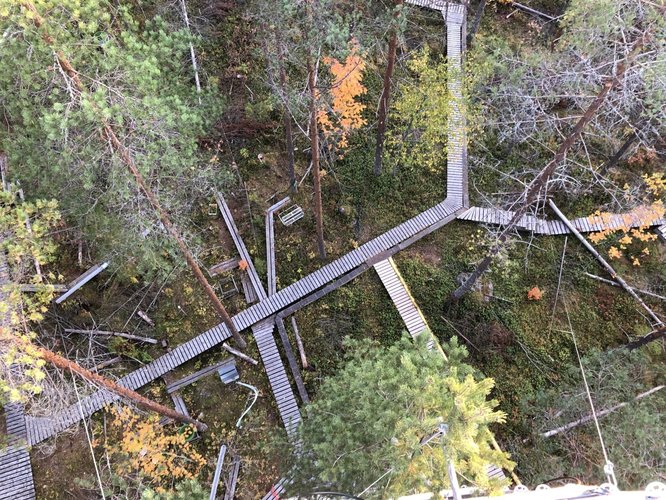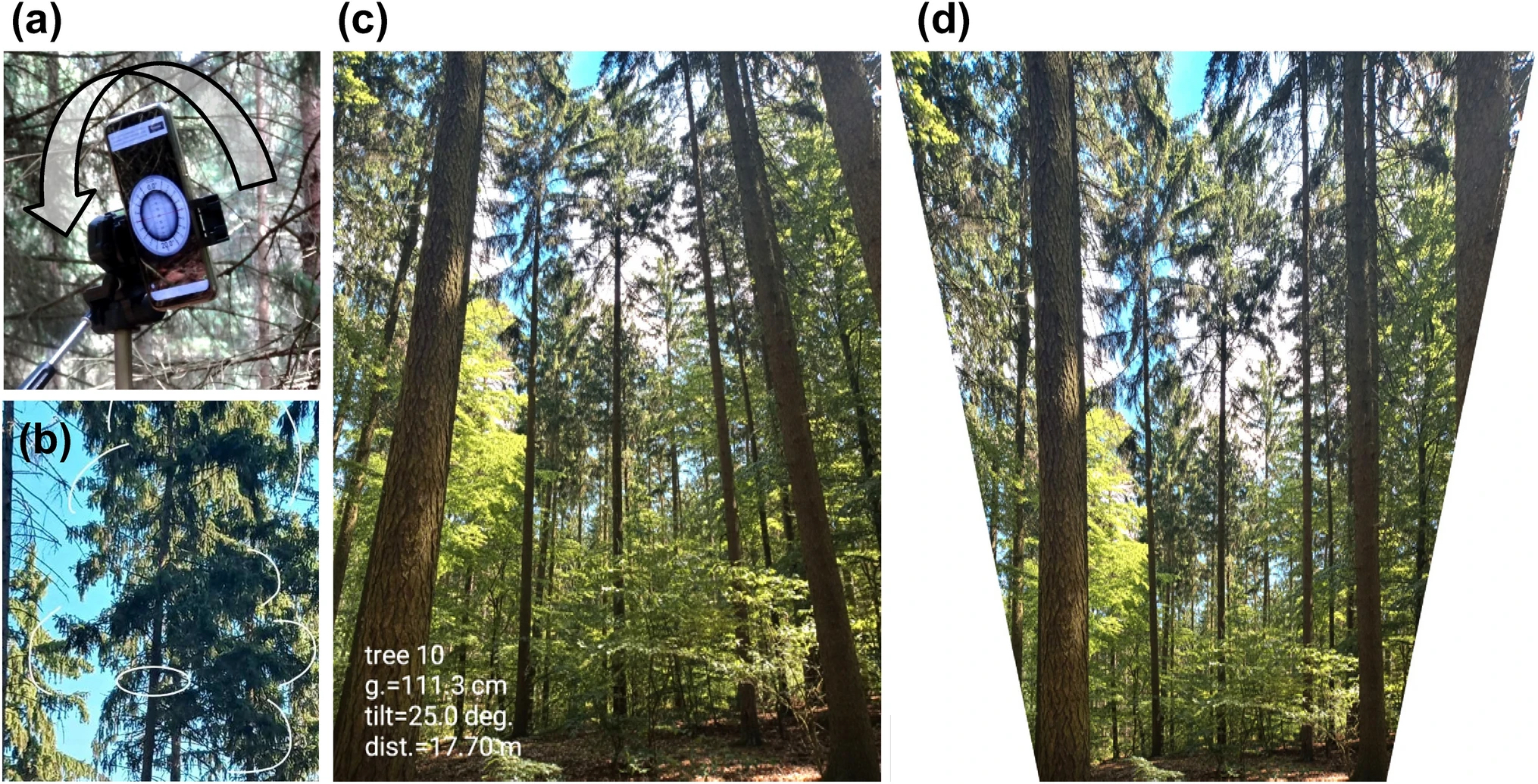Hybrid Walking and (Un)Sensing the Forest
On Sunday 13 November 2022, the Open Forest Collective (Andrea Botero, Markéta Dolejšová, Jaz Hee-jeong Choi, and Chewie the dog) hosted an experimental walk in Hyytiälä Forestry Field Station, also known as SMEAR II (Station for Measuring Ecosystem-Atmosphere Relations), in a Scots pine forest in Finland. Participants joined the walk in-person – in the cold and amber light of the winter afternoon – or over Zoom from multiple spaces and time zones. This story weaves together different perspectives of the walk, through patchy connections and distributed sensing .
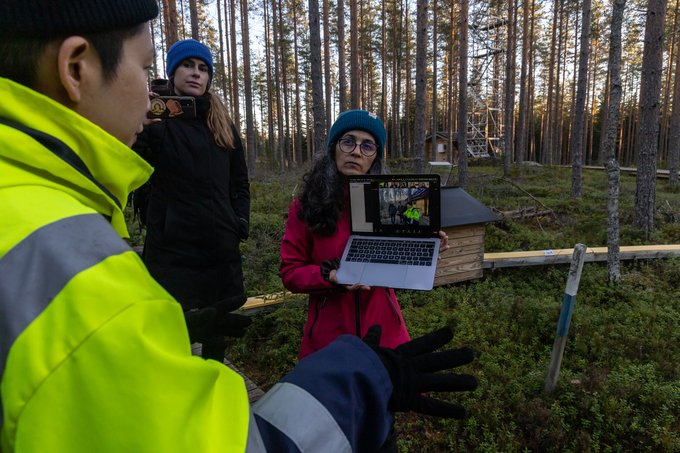
Jaz addresses the virtual walkers, facilitated by Markéta (with a phone) and Andrea (with a laptop). Image source: Mariela Urra Schiafino. Reproduced with permission.
Bad data (KLH)
At a distance from Hyytiälä, I’d considered walking in parallel somewhere as close to a forest as I could find in East London , Zooming in for as long as the data plan on my phone would allow. But the morning of the walk I wake up sick, my body too weak for walking long distances, my senses slightly blurred. Propped up in bed with my headphones in I roll a spiky London plane seed I’d picked up a few days earlier – waterlogged, dried out again, and now light and hollow – around in my hand.
A few weeks before, I’d listened to Andrea give a paper about more-than-human data and stories at Hyytiälä as part of The Forest Multiple workshop in Cambridge . Andrea mentioned conversations with and between scientists at Hyytiälä about what to do when trees start producing "bad data", when the information they offer about their environments becomes unreliable, suggesting interference or depletion in the trees’ capacities to support monitoring technologies. When this happens the scientists often swap the sensors and other monitoring devices from one tree onto another, taking into account their differences.
A few minutes after the walk begins, the laptop Andrea is carrying around to guide remote participants runs out of battery. From Markéta’s phone, we see Andrea rummage around in a rucksack, get another laptop, try again. This time the battery power lasts – and we are taken along boardwalks across berry bushes ("it’s the wrong time for berries", says Andrea, and yet there they are in the changing climate), through birdless trees ("the birds stay away from here", from the incessant hum of the forest’s data infrastructures that Zoom suppresses as background noise ), up scaffolded steps into the canopy in the winter afternoon’s slanting sun. While the in-person walkers catch their breath, remote walkers share vignettes about the forest objects they have brought to the meeting, and then the in-person walkers share theirs.
In these moments of hybrid gathering – incompletely, sometimes glitchily – I’m reminded of disability culture activist/artist Petra Kuppers’ series of poems "Moon Botany". Kuppers writes:
"The Moon Botany series began as an exercise in armchair botany: my friend and visual artist Sharon Siskin went on wheelchair-inaccessible nature hikes and brought back found materials for a creative exchange with me. She arranged the physical objects on the wooden table of our artist-residency hut in the Oregonian outback, and I provided new narratives and emotional containers."
In one poem tracing the journey of a ‘wet Redwood forest’ remade into pond decking, Kuppers locates these objects in histories of dispossession and extraction in the place currently called the United States. At the same time, she suggests possibilities for sensing across different, distributed, and interdependent bodies via technological and storytelling devices. Remembering this, from my perspective in bed and not (not) in the forest, the experimental walk becomes a way of assembling, attending and attuning to "bad data" – the noise of unsound bodies and technologies – differently.
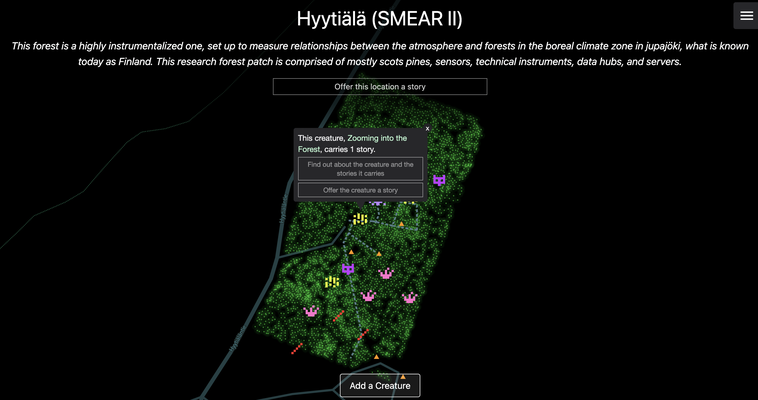
Hyytiälä on the Feral Map, where users are invited to add stories and creatures. Image source: Feral Map [screenshot]. Retrieved 8 February 2023, from https://feral.more-than-human-derive.net/?loc=aalto
Forest(s) aliveness (MW)
Moments before logging into the Zoom meeting for this remote forest walk, I am watching a group of deer roaming through the forest in a YouTube live stream of a Dutch National Park. Comfortably seated at home with a cup of coffee and a nearly finished woodcarving project, I watch the deer pass by. It is cloudy in Cambridge, but on the livestream I can see that it is sunny in the Netherlands . Much sunnier than on the other days I watched this channel. The static camera reveals more details in the sun’s reflections, including insects, a spider web, patches of grass, and the moving shadows of the trees. The camera always records the exact same landscape of a protected forest area in The Hoge Veluwe. The longer I watch, the more details emerge as the weather changes and different animals become visible. This forest is alive.
I click on the Zoom link, and I am transported to Finland. A small group of people online and offline joined for our walk. This is my second remote walk in this high-tech forest. The last time I joined, the people in the forests wore face masks and t-shirts. Now they are wearing winter jackets and carry backpacks. Andrea carries us Zoomers on a laptop while guiding the tour, pointing the laptop’s camera at various scenes. Markéta films other parts of the forest with her smartphone, so we can see two perspectives at once. Because of the cold weather, the laptop’s battery dies, so we continue the walk on the smartphone. They introduce us to different sensors and share the history of one of the most technological forests in the world. Cables on the ground carry sensor recordings to nearby data hubs. A constant buzzing sound signals all the technology that is at work here to help researchers understand things like atmospheric gasses, radiation, and carbon absorption. One in-person participant describes these sounds as ‘shocking’, but they are difficult to hear via Zoom. Few animals visit this part of the forest. Perhaps they are deterred by this constant buzzing sound. Or maybe the bright and moving technological objects are intimidating to them. Or perhaps the smells of electronics and data managers keeps them away. As part of their research project, Andrea, Jaz and Markéta encourage us to share our thoughts on the Feral Map, a growing collection of stories and creatures that recount the experiences of other visitors. This forest, too, is alive.
After the guided tour, I exit the Zoom call and return to the YouTube livestream to check on the Dutch deer. They have left the scene. I reflect on the different ways of tuning into the forest through these technologies – both of these remote connections enable in-depth views of a landscape and reveal partial perspectives. Today I met new people, deer, trees, and insects, but after logging out I almost immediately lose my attachments to these entities. My body is stiff from sitting in the chair for hours. I should go for a walk.
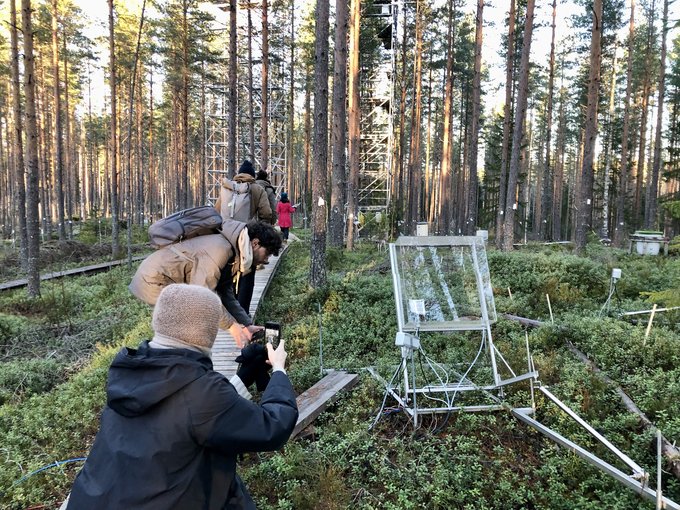
In-person walkers look at the sensors in the forest. Image source: Nathaly Pinto. Reproduced with permission.
Paths are made while you walk (ABC)
It’s a crisp morning in Hyytiälä, and we are hosting another hybrid walk through the SMEAR II station and forest patch. I am grateful this time Jaz is able to be here with us, with a full-fledged body, as so far they have only seen this place from the screen, from pictures and through the strange stories Markéta and I expose them to regularly. We are soon to be joined by a group of around ten enthusiast fellow walkers – a seven-year-old included – who decided that a walk in a research forest is incentive enough for them to take an early train on a Sunday. I bring my laptop to be able to also take on board those joining via video connection. Each time it gets easier to carry faces around on a screen; I have become a better walking laptop camera woman, and our story script is more solid. I feel confident – we have done this before.
There we are walking around the pines and the sensors and the tubes, covered by the humming of the instruments and the cold. Inevitably some things go to crap as sometimes they do. The cold drained the battery of the laptop and for a few seconds I lost our virtual guests; Jaz and Markéta reacted quickly and helped me get strapped again to another laptop. There were other glitches too: we made unplanned stops, forgot some anecdotes or got entangled far away by conversations with our fellow explorers. I am here, but I am also there, it’s hard to pay attention to those on the screen and those around us at the same time.
I feel like the multitasking Mänty (pine) in front of me. The mänty needs to be a tree – it casts shade, it photosynthesises, it releases important volatile organic compounds (VoCs) to exchange with the atmosphere so that there is rain and snow, while at the same time it is asked to provide data for the station. There are too many conversations at the same time in different registers, the forest(s) is too alive (like Michelle points out?), we aren’t good at multitasking. However, to be sincere, probably the tree has it harder than me, and we are both better at multitasking than we want to recognize. Probably I also produced some of the “bad data” I told Kate about while in Cambridge. We somehow managed, because we walked, and we talked, and I felt connections. Everybody felt they made insights; we created lovely stories.
Header image: Hyytiälä Forestry Field Station. Image source: Andrea Botero. Reproduced with permission.
Smart Forests Atlas materials are free to use for non-commercial purposes (with attribution) under a CC BY-NC-SA 4.0 license. To cite this story: Lewis Hood, Kate, Michelle Westerlaken, and Andrea Botero Cabrera, "Hybrid Walking and (Un)Sensing the Forest," Smart Forests Atlas (2023), https://atlas.smartforests.net/en/stories/hybrid-walking-and-unsensing-the-forest. DOI: 10.5281/zenodo.13868750.
